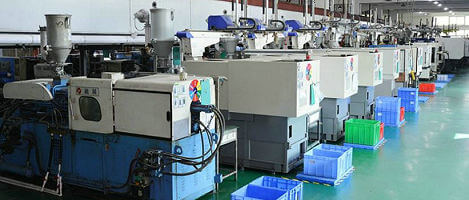In today’s world, Plastic has become has an integral part of the manufacturing process. It is used in various shapes and forms for different purposes in almost all spheres of life, from homes to factories and large industries. Hence, it is important to look at how this plastic is molded to fit our needs and requirements.
Plastic injection Molding is a process through which liquid plastic is molded into a customized shape by pouring it into a mold and applying certain degrees of pressure and temperature. Polymers such as Polyethylene or Polypropylene are used in this manufacturing process. There are several types of Plastic Molding techniques implemented by manufacturers, differing on the basics of technique, expenses, and benefits.
Contact Information:-
DONGGUAN SINCERE TECH CO.LTD
Rm101, Number 2, Street 11, Wen Ming South Road,
Qiaotou, QiaotouZhen, Donggguan City,
Guangdong Province, China. 523000.
Mobile: +86 135 30801277
Email: info@plasticmold.net
There are several type of plastic molding process below.
- Extrusion Molding (Injection mold China):
This molding process differs from the rest of the processes due to the fact that the plastic is extruded into the die, instead of the plastic resins being inserted into the shaping mold. Extrusion Molding involves passing molten plastic through a customizable hole to produce a long-shaped part.
The process basically produces customized dough that is pressed into the desired shape. The differentiating factor is that the plastic takes the shape of the die and not the mold. Lengthy, hollow, and cross-sectional parts are mainly the focal production of extrusion moldings, such as pipes, tubes, and straws in various designs like T-sections, U-sections, square sections, I-sections, L-sections, and circular sections. It is also employed in the production of automotive parts, hoods, fenders, scoops, and spoilers.
Extrusion Molding is relatively less expensive because the mechanism employed is fairly simple and has high productivity. Though, this type of plastic molding technique is limited in regard to the kind of product that can be produced.
- Blow Molding (injection moulding China):
Blow Molding is very similar to the art of glass molding and produces thinly walled and hollow customized parts. Plastic products with very uniform wall thickness are produced through this methodology. A molten plastic mass is taken and the air is injected into it. Similar to how a balloon is blown; the plastic mass is filled with air until it fits the shape of the mold. It is then left to cool down and extracted from the mold.
Blow Molding is an economical way of manufacturing one-piece hollowed-out plastic containers in large numbers, such as bottles, drums, and storage containers. Uniform, thin-walled containers are produced at a rapid speed and in a 12-hour workday, around 1400 pieces are the normal output.
- Rotational Molding (injection mould China):
Rotational molding is also referred to as Rotomolding and it involves high temperature and rotation. Molten plastic is poured into a mold and put in a sort of an oven, whose base rotates at high speed. Due to centripetal force, the plastic covers the interior walls of the mold, forming an evenly shaped hollow container.
This type of molding technique is relatively slower than the others in terms of production rates, but it is environmentally friendly. It is cost-effective and perfect for start-ups, as the initial monetary input is smaller. Whatever excess material falls out of the mold during production, can simply be reused.
Rotational Molding is generally used in the production of Big, hollow, and one-piece containers like tanks, kayaks, car parts, road cones, etc. They are also highly customizable, with the option to add designs, curves, or logos into the mold and thus, the final product.
- Compression Molding (injection molded parts):
In compression molding, molten or heated plastic is placed into a heated mold. High pressure is then applied to the mold, thus compressing the plastic into the shape of the mold. This curing process involves the production of high-integrity plastics. This durability is ensured by the use of advanced composites for plastic materials. Thermosetting resins, fiberglass, and reinforced plastics are used for this.
The strength and versatility of the plastic produced through this process allow for it to be used in a variety of applications from automotive parts, household appliances, clothing fasteners, to body armor. Making replacement plastic parts for broken metallic mechanisms is one of the most efficient uses of this methodology.
Depending on the complexity of the design, cavities, and strength, the cost of the production of the plastic through this method, may vary. But, compared to some other molding processes, Compression Molding is less expensive.
- Injection Molding:
Identical plastic parts with high tolerance are mass-produced through Injection Molding. In Injection Molding, molten polymer granules are injected into the mold under high pressure and then left to cool down and solidify. Thermoplastic polymers are used, as they can be colored or injected with other embellishments.
The process is extremely versatile and capable of producing a large variety of plastics, from house appliances to automobile parts, and due to its flexibility, its use is employed even in aerospace technology and the medical field. Injection molding produces products with high precision and the products are always almost identical. The method of the process allows the inclusion of complex designs and patterns to be engraved onto the product.
The process is very cost-efficient. The initial investment for Injection Molding is quite high, and the turn in requires some wait, but the resulting profit is very high and the products are highly durable and strong. It is also an environmentally friendly process and can be automated to a great extent.
- Thermoforming:
In Thermoforming, Thermoplastic, which is a thin sheet of plastic, is heated until it becomes pliable. It is then put into a mold and shaped according to it. After trimming and cooling, it is ready for the market. It is an inexpensive process and various types of plastics and molds can be used for this purpose. It is used for the production of fridge liners, lids, clamshells, and disposable cups.
All of these methods are generally used in various industries. They all have their advantages and disadvantages. Each method had one major focal advantage and thus is the reason for its usage.
If you are looking for plastic injection molding service from China, you are welcome to contact us,
We are an injection molding China company, offer custom plastic injection molding and molding from China to the world. Check more detail by https://www.plasticmold.net/injection-moulding/


















No Comments